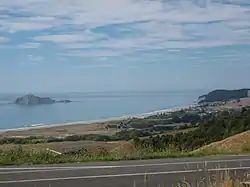Waimārama
Waimārama is a seaside village in Hastings District, Hawke's Bay, New Zealand.
Waimārama | |
|---|---|
 Waimārama from the hills above, with Bare Island to the left | |

| |
| Coordinates: 39°48′58″S 176°59′24″E | |
| Country | New Zealand |
| Region | Hawke's Bay |
| Territorial authority | Hastings District |
| Ward | Kahuranaki |
| Population (2018)[1] | |
| • Total | 216 |
Waimārama is a popular surf beach, known as a beach break on a sandy beach, with a rocky point. It offers both left and right handers and conditions are often suitable for surfers of all levels. The beach has strong rip currents, and is patrolled by surf lifeguards at weekends from November to March.[2]
Motu-o-Kura or Bare Island is located just off the coast and is a popular spot for fishing and diving. The beach town attracts people from across the region, with a restaurant, bar and shop. It also has about 240 permanent residents, with many former holiday baches becoming homes.[3]
On 28 April 2011, heavy rain hit the village, causing floods and mudslides.[4]
Demographics
The population of Waimārama was 216 in the 2018 census, an increase of 33 from 2013. There were 111 males and 105 females. 80.6% of people identified as European/Pākehā, 31.5% as Māori, 1.8% as Pacific peoples and 1.4% of each of Asian and other ethnicities. 16.7% were under 15 years old, 13.9% were 15–29, 48.6% were 30–64, and 22.2% were 65 or older.[1]
| Year | Pop. | ±% p.a. |
|---|---|---|
| 2006 | 1,104 | — |
| 2013 | 1,173 | +0.87% |
| 2018 | 1,413 | +3.79% |
| Source: [5] | ||
The statistical area of Kahuranaki, which at 368 square kilometres is much larger than this village, had a population of 1,413 at the 2018 New Zealand census, an increase of 240 people (20.5%) since the 2013 census, and an increase of 309 people (28.0%) since the 2006 census. There were 495 households. There were 711 males and 702 females, giving a sex ratio of 1.01 males per female. The median age was 44.4 years (compared with 37.4 years nationally), with 285 people (20.2%) aged under 15 years, 207 (14.6%) aged 15 to 29, 720 (51.0%) aged 30 to 64, and 195 (13.8%) aged 65 or older.
Ethnicities were 87.3% European/Pākehā, 20.6% Māori, 1.3% Pacific peoples, 0.6% Asian, and 2.1% other ethnicities (totals add to more than 100% since people could identify with multiple ethnicities).
The proportion of people born overseas was 19.7%, compared with 27.1% nationally.
Although some people objected to giving their religion, 53.9% had no religion, 35.0% were Christian, 0.2% were Hindu, 0.2% were Muslim, 0.4% were Buddhist and 3.6% had other religions.
Of those at least 15 years old, 285 (25.3%) people had a bachelor or higher degree, and 129 (11.4%) people had no formal qualifications. The median income was $37,500, compared with $31,800 nationally. The employment status of those at least 15 was that 615 (54.5%) people were employed full-time, 201 (17.8%) were part-time, and 30 (2.7%) were unemployed.[5]
Marae
The local Waimārama Marae and Taupunga meeting house is a meeting place for the Ngāti Kahungunu hapū of Ngāti Hikatoa, Ngāti Kurukuru, Ngāti Urakiterangi and Ngāti Whakaiti.[6][7]
In October 2020, the Government committed $6,020,910 from the Provincial Growth Fund to upgrade a group of 18 marae, including Waimārama Marae. The funding was expected to create 39 jobs.[8]
Education
Waimārama School is a co-educational state primary school,[9][10] with a roll of 11 as of March 2020.[11][12]
Notes
- "Age and sex by ethnic group (grouped total response), for census usually resident population counts, 2006, 2013, and 2018 Censuses (urban rural areas)". Statistics New Zealand. Retrieved 23 January 2021.
- "Waimarama Surf Lifesaving Club". waimaramasurf.org.nz.
- "Waimarama Travel Guide". Jasons Travel Media.
- "Extent of Waimaramara floods sinks in". New Zealand Media and Entertainment. Hawke's Bay Today. May 2011.
- "Statistical area 1 dataset for 2018 Census". Statistics New Zealand. March 2020. Kahuranaki (212200). 2018 Census place summary: Kahuranaki
- "Te Kāhui Māngai directory". tkm.govt.nz. Te Puni Kōkiri.
- "Māori Maps". maorimaps.com. Te Potiki National Trust.
- "Marae Announcements" (Excel). growregions.govt.nz. Provincial Growth Fund. 9 October 2020.
- "Waimarama School Official School Website". waimarama.school.nz.
- "Waimarama School Ministry of Education School Profile". educationcounts.govt.nz. Ministry of Education.
- "New Zealand Schools Directory". New Zealand Ministry of Education. Retrieved 26 April 2020.
- "Waimarama School Education Review Office Report". ero.govt.nz. Education Review Office.